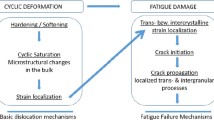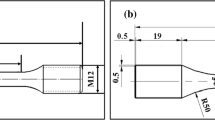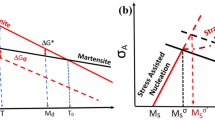Abstract
The maximum persistent slip band (PSB) width in cyclic loading is experimentally proven to be a material property in this paper. The dependence of the maximum PSB width on grain size, selected as a microstructural property of the material, is tested and reported. The effect of strain conditions, which conversely is not a material property of copper, is also included in the study. The results demonstrate that the maximum PSB width of annealed copper (grain size = 104.2 µm) is statistically the same within this class of grains, and is statistically larger than that of the stress-relieved copper (grain size = 14.2 µm). In contrast, the PSB width evolution is not sensitive to different strain conditions. These findings advance the fundamental understanding of how persistent slip band formation is influenced by variations in fatigue mechanical stimulus and metallurgical characteristics.













Similar content being viewed by others
References
Y. Choi and C.R. Liu, Wear, 2006 261(5) 485–91.
Y. Choi, C.R. Liu, Wear 2006, 261(5):492–99.
Carpinteri A, Vantadori S (2009) International Journal of Fatigue, 31(4), 759–65.
Carpinteri, Andrea, Filippo Berto, Alberto Campagnolo, Giovanni Fortese, Camilla Ronchei, Daniela Scorza, and Sabrina Vantadori, Theoretical and Applied Fracture Mechanics, 2016, Notch Mechanics 84, pp. 57–63.
C.R. Liu, Y Choi, International Journal of Mechanical Sciences 2008, 50(2), 117–23.
A. Weidner, R. Beyer, C. Blochwitz, C. Holste, A. Schwab, and W. Tirschler, Materials Science and Engineering: A, 2006, 435–436, pp. 540–46.
C. Erel, G. Po, N. Ghoniem, Philosophical Magazine 2017, 97(32), 2947–70.
K. S. Chan, J. W. Tian, B. Yang, and P. K. Liaw, Metall and Mat Trans A, 2009, vol. 40, no. 11, pp. 2545–2556.
A.S. Cheng, C. Laird, Fatigue & Fracture of Engineering Materials & Structures 1981, 4(4), 331–41.
T. Mura and Y. Nakasone, J. Appl. Mech, 1990, vol. 57, no. 1, pp. 1–6.
M. E. Fine and S. P. Bhat, Materials Science and Engineering: A, 2007, vol. 468–470, pp. 64–69.
Voothaluru R, CR Liu, Fatigue & Fracture of Engineering Materials & Structures, 2014, 37(6), 671–81.
R. Voothaluru: Purdue University, Thesis PhD, 2014.
Voothaluru R. and C. RichardLiu, Fatigue & Fracture of Engineering Materials & Structures 2013, 36(7), pp. 670–78.
M. R. Lin, M. E. Fine, T. Mura, Acta Metallurgica, 1986, 34(4), pp. 619–628.
SP. Bhat, ME. Fine, Materials Science and Engineering A 2001 314(1), 90–96.
K. Tanaka, T. Mura, Journal of Applied Mechanics 1981, 48(1), 97–10.
K. S. Chan, Metall and Mat Trans A, 2003, vol. 34, no. 1, pp. 43–58.
S.E. Harvey, P.G. Marsh, W.W. Gerberich (1994) Acta Metallurgica Materialia 42(10): 3493–3502.
J. Man, K. Obrtlík, J. Polák, Philosophical Magazine 2009 89(16): 1295–1336.
J. Ahmed, S.G. Roberts, A.J. Wilkinson, Philosophical Magazine 2006 86(29): 4965–81.
M. Zaiser, W. Frank, Applied Physics A 1995, 60(5): 497–503.
S.X. Li, Y. Li, G.Y. Li, J.H. Yang, Z.G. Wang, K. Lu, Philosophical Magazine A, 2002, 82(5), 867–83.
ASTM International: ASTM E606 / E606M-12, ASTM International, West Conshohocken, PA, 2012, www.astm.org
ASTM International: ASTM E3, ASTM International, West Conshohocken, PA, 2017, www.astm.org
ASTM International: ASTM E407-07, ASTM International, West Conshohocken, PA, 2015, www.astm.org
ASTM International: ASTM E112-13, ASTM International, West Conshohocken, PA, 2013, www.astm.org
A.S. Cheng, and C. Laird, Materials Science and Engineering 1983, 60(2), 177–83.
S. B. Green, Multivariate Behavioral Research, 1991, 26(3),499-510
Acknowledgments
This work is supported by the National Science Foundation (CMMI), through Grant No. 1562960 and is gratefully acknowledged.
Author information
Authors and Affiliations
Corresponding author
Additional information
Publisher's Note
Springer Nature remains neutral with regard to jurisdictional claims in published maps and institutional affiliations.
Manuscript submitted July 15, 2019.
Rights and permissions
About this article
Cite this article
Ou, CY., Liu, C.R. The Effects of Grain Size and Strain Amplitude on Persistent Slip Band Formation and Fatigue Crack Initiation. Metall Mater Trans A 50, 5056–5065 (2019). https://doi.org/10.1007/s11661-019-05423-6
Received:
Published:
Issue Date:
DOI: https://doi.org/10.1007/s11661-019-05423-6




